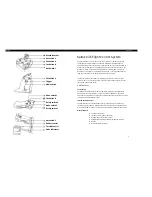
29
Tensor
2
Offset
Control variance
Setting of the max. variance allowed between actual and set value of the controller (Standard variance).
The allowed variance is stated in % depending on the set travel of the actuator.
An override of the set max. variance will indicate an error at the message output (see "Status Info").
Possible settings:
0 = Standard variance check deactivated
1...9% = Allowed standard variance in %
Example:
Menu setting = 2%
Right end position 0% [0°] / Left end position 100% [90°]. A 90° travel corresponds to a max. allowed variance of
90° x 2% = 1.8°. The message output opens on a variance of the actual position from the set position of >1.8°.
Hyst. stop
Shut-off hysteresis
The shut-off hysteresis defines the shut-off accuracy of the actuator when reaching the default set value position. The
actual position of the actuator is checked against the set position and the default hysteresis value. The actuator stops if
the actual position lies within the (shut-off) hysteresis range around the set value.
The shut-off hysteresis of the actuator in control mode can be set in steps of 0.01% in a range of 0…5.00%.
The shut-off hysteresis has to be set lower than the turn-on hysteresis!
If the hysteresis is set too low, the actuator may operate in an unwanted behaviour depending on the actuator type. In
this case, the hysteresis must be increased.
Hyst. start
Turn-on hysteresis
The turn-on hysteresis defines at which variance from the actual position to the set position the actuator will readjust.
The actual position of the actuator is checked against the set position and the default hysteresis value. If the actual
position of the actuator lies outside the (tun-on) hysteresis range around the set position, the actuator moves to the
deafult set position.
The turn-on hysteresis of the actuator in control mode can be set in steps of 0.01% in a range of 0…5.00%.
The turn-on hysteresis has to be set higher than the shut-off hysteresis!
If the hysteresis is set too low, the actuator may operate in an unwanted behaviour depending on the actuator type. In
this case, the hysteresis must be increased.
ADVICE
!
ADVICE
!
















































